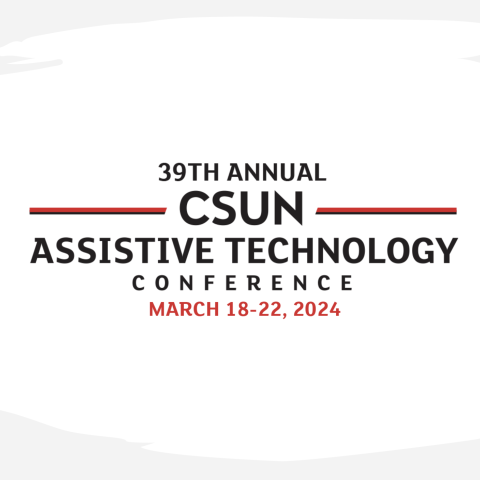
Smith-Kettlewell’s Rehabilitation Engineering Research Center (RERC) on Blindness and Low Vision, funded by the National Institute on Disability, Independent Living and Rehabilitation Research (NIDILRR), supports eight projects related to visual impairment and accessibility. Several RERC project leads and researchers presented their latest work at the CSUN 2024 conference in Anaheim, California from Mar 18-22. The CSUN Assistive Technology Conference is the premier forum on technology for all persons with disabilities that provides a platform for researchers, practitioners, educators, exhibitors and more from around the world to engage with each other and share knowledge, innovations and best practices to promote inclusion for all.
RERC researchers who presented this year at CSUN:
 Dr. Catherine Agathos, postdoctoral fellow at SKERI, gave a presentation, “Self-Reported Mobility Difficulties in Macular Degeneration,” addressing the underappreciated connection between mobility difficulties and central field loss due to macular degeneration. In collaboration with Dr. Don Fletcher, a leading ophthalmologist in the field of low vision rehabilitation, the researchers found that just a few basic questions regarding mobility during routine consultation can significantly change the course of the visit and reveal a major limitation in patients’ daily lives. Resulting increase in referrals to physical therapy and orientation and mobility specialists can potentially address these limitations improving safety and quality of life in those with low vision due to central visual field loss.
Dr. Catherine Agathos, postdoctoral fellow at SKERI, gave a presentation, “Self-Reported Mobility Difficulties in Macular Degeneration,” addressing the underappreciated connection between mobility difficulties and central field loss due to macular degeneration. In collaboration with Dr. Don Fletcher, a leading ophthalmologist in the field of low vision rehabilitation, the researchers found that just a few basic questions regarding mobility during routine consultation can significantly change the course of the visit and reveal a major limitation in patients’ daily lives. Resulting increase in referrals to physical therapy and orientation and mobility specialists can potentially address these limitations improving safety and quality of life in those with low vision due to central visual field loss.
 Dr. Santani Teng, Associate Scientist at SKERI, presented his work, “Design and Optimization of Assistive Ultrasonic Echolocation," which will be published in the 2024 edition of the CSUN Journal. This work, done in collaboration with Ian Reynolds, describes “Robin,” a prototype wearable device for human echolocation drawing inspiration from echolocating bats, which is designed to help people with visual impairments learn to use echolocation cues for mobility and understanding the nearby 3D environment.
Dr. Santani Teng, Associate Scientist at SKERI, presented his work, “Design and Optimization of Assistive Ultrasonic Echolocation," which will be published in the 2024 edition of the CSUN Journal. This work, done in collaboration with Ian Reynolds, describes “Robin,” a prototype wearable device for human echolocation drawing inspiration from echolocating bats, which is designed to help people with visual impairments learn to use echolocation cues for mobility and understanding the nearby 3D environment.

Brandon Biggs, Engineer at SKERI, PhD student at Georgia Tech and Founder of XR Navigation, gave three presentations related to his work on Audiom, a non-visual web-based map viewer: “The First WCAG AAA Compliant Digital Campus Map,” “The Future of Inclusive Digital Indoor Maps and Navigation,” and “The Digital Drawing WYSIWYG Editor for Blind Users is Here.” In Audiom, the user is an avatar that navigates, using the arrow keys, through geographic data, as if they are playing a first-person, egocentric game. The resulting audio virtual reality interface thereby makes digital maps accessible to persons with visual impairments. Audiom is a first of its kind tool that provides access to rich, multimodal information usually only available to sighted users through maps, to all users who are blind or visually impaired.
Dr. Sile O’Modhrain, Associate Professor of Information Science at University of Michigan, CIO of NewHaptics, and one of the RERC investigators, participated in an exhibition of NewHaptics’ refreshable braille display – one of Dr. O’Modhrain’s many exciting projects in the accessibility space. This project focuses on making a compact, portable, and large-area tactile “screen,” which has the potential to make a multi-line tactile display that a user can interact with to access braille documents and tactile graphics that can change dynamically over time.

Steve Landau, President and Founder of Touch Graphics, demonstrated his company’s new T3 Creator system, which makes it easy to create audio labels for tactile graphics using the T3 Tactile Tablet. This system will expand the accessibility of a range of tactile graphics that would otherwise be inaccessible to people who have limited knowledge of braille or limited experience interacting with tactile graphics.
This conference provided not only a forum for our researchers to exhibit their work but also an opportunity to learn about other key advances and major problems in the field, as well as invaluable feedback from fellow researchers, members of the blind and visually impaired community, as well as practitioners and educators, all of whom have important perspectives on the broad and dynamically changing field of blindness and low vision rehabilitation.
